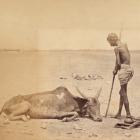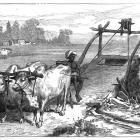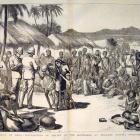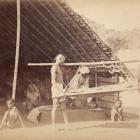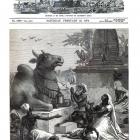Forests
While the transition to commercialized agriculture under colonial rule clearly exacerbated food shortages in late nineteenth century India, other government policies such as British forestry law played a role as well. The colonial rulers may have intended to restrict forest access simply in order to protect timber resources. Yet these rules had the effect of cutting off natives’ access to forest ecosystems that had previously served as a buffer when agricultural crops failed. British authorities enacted a series of forest acts beginning 1860. These laws began to convert open forest areas into reserved forest areas, where colonial government permission was required to enter to collect timber and non-timber forest products.15 Forest dwellers and local people lost access to resources they had traditionally used as a cushion in times of crisis.16 The colonial regulation of forests posed a particular threat to the Adivasi people, the aboriginal people of India, endangering both the natural resources from which they derived sustenance, and the geographic sites that were central to their culture and religion.17 Contemporary voices saw this happening: in 1880, Valentine Ball pointed out that “the reservation of forest tracts which prohibits the inhabitants from taking a blade of grass from within the boundaries, has resulted in the people being cut off from these food sources throughout wide areas, and many have been forced to migrate in consequences to other regions…where they can continue to supplement their scanty cultivation with the productions afforded to them by nature.”18
In spite of restricted access, the forests continued to serve as a valuable resource to some native groups in India. In his observation of the famine-affected regions in 1867, Ball learned that people living in forest villages were more independent and less affected by famine than those who reside in centers of cultivation and had no access to forests. The forests were a life-saving resource for the lower classes, supporting them with products such as fruits, honey, and tubers. Those who were excessively dependent on rice were more prone to succumb to hunger.19 The forests thus served as a valuable resource at the periphery of the agricultural system of colonial India, impacting human survival during times of famine.
15 M. Gadgil and R. Guha, The Fissured Land: An Ecological History of India (Delhi: Oxford University Press, 1992); B. Weil, “Conservation, Exploitation, and Cultural Change in Indian Forest Service 1875–1927,” Environmental History 11, no. 2 (2006): 319–43; S. Ghosal, “Pre-Colonial and Colonial Forest Culture in the Residency of Bengal,” Human Geographies 5, no. 1 (2011): 111.
16 M. Fried, The Notion of Tribe (Melo Park: California, Cummings Pub. Co., 1975); Ghosal, “Pre-Colonial and Colonial Forest Culture,” 107.
17 D. Sinha, “Proletarization of a Hunting and Gathering Tribe: The Case of Hill Khera of Purulia,” in Changing Land Systems and Tribals of Eastern India in the Modern Period, ed. R. Banerjee (Calcutta : Subarnarekha, 1989), 73–74; N. K. Mahato, “Environmental Change and Chronic Famine in Manbhum, Bengal District, 1860–1910,” Global Environment 6 (2010): 83–84.
18 V. Ball, “On Jungle Products Used as Articles of Food in Chutia Nagpur,” in Tribal and Peasant Life in Nineteenth Century India, ed. The General Secretary (New Delhi: Usha Publication, 1880), 695; Mahato “Environmental Change and Chronic Famine,” 84–85.
19 V. Ball, “On the Products Used as Articles of Food by the Inhabitants of the District of Manbhum and Hazaribagh,” Journal of the Asiatic Society of Bengal 36, no. 2 (1867): 73–82; Ibid, “Notes on the Kherias, an aboriginal Race Living in the Hill Tracts of Manbhum,” in Proceedings of the Asiatic Society of Bengal, ed. The General Secretary (Calcutta: Baptist Mission Press, 192); Mahato, “Environmental Change and Chronic Famine,” 88.






